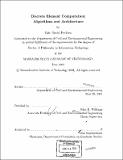| dc.contributor.advisor | John R. Williams. | en_US |
| dc.contributor.author | Perkins, Eric David, 1975- | en_US |
| dc.contributor.other | Massachusetts Institute of Technology. Dept. of Civil and Environmental Engineering. | en_US |
| dc.date.accessioned | 2010-09-03T18:51:56Z | |
| dc.date.available | 2010-09-03T18:51:56Z | |
| dc.date.copyright | 2001 | en_US |
| dc.date.issued | 2001 | en_US |
| dc.identifier.uri | http://hdl.handle.net/1721.1/58440 | |
| dc.description | Thesis (Ph. D.)--Massachusetts Institute of Technology, Dept. of Civil and Environmental Engineering, 2001. | en_US |
| dc.description | Includes bibliographical references (leaves 156-166). | en_US |
| dc.description.abstract | The Discrete Element Method is a numerical technique used to model physical phenomena through the dynamic interactions of a large number of distinct bodies. The strength of the method lies in its ability to accurately model the behavior of inherently discontinuous media, such as granular, fractured, or powdered materials. The major computational obstacle in discrete element simulation is the automatic detection of contacts between bodies. For large simulations, the complexity of the contact detection process is driven by the general spatial reasoning problem of neighbor searching, in which candidate intersection pairs are selected based on their proximity. Neighbor search algorithms exist that exhibit linear scaling in the number of bodies. These algorithms rely, however, on the assumption of uniformly sized objects. Devaitions from this assuption, inherent in many common physical systems, significantly degrade performance. This thesis presents a new grid-based algorithm which accomodates objects of varying size. A new grid-based neighbor search algorithm, called CGrid, is developed to deal with objects of varying sizes. A generic formulation for any number of dimensions is presented. CGrid scales linearly in the number of bodies, and is less sensitive to object size disparity than existing linear algorithms. By combining performance and robustness, CGrid provides a reliable neighbor search solution for general simulation systems. An architecture for simulation is presented, which is designed to support rapid prototyping and extension development.. The core architecture provides an infrastructure of generic components for simulation management. The simulation object heirarchy is constructed to address the issues associated with developing extension capabilities, and supporting the wide variety of objects and behaviors which can be employed within the Discrete Element Method. | en_US |
| dc.description.statementofresponsibility | by Eric David Perkins. | en_US |
| dc.format.extent | 166 leaves | en_US |
| dc.language.iso | eng | en_US |
| dc.publisher | Massachusetts Institute of Technology | en_US |
| dc.rights | M.I.T. theses are protected by
copyright. They may be viewed from this source for any purpose, but
reproduction or distribution in any format is prohibited without written
permission. See provided URL for inquiries about permission. | en_US |
| dc.rights.uri | http://dspace.mit.edu/handle/1721.1/7582 | en_US |
| dc.subject | Civil and Environmental Engineering. | en_US |
| dc.title | Discrete element computation : algorithms and architecture | en_US |
| dc.type | Thesis | en_US |
| dc.description.degree | Ph.D. | en_US |
| dc.contributor.department | Massachusetts Institute of Technology. Department of Civil and Environmental Engineering | |
| dc.identifier.oclc | 49522855 | en_US |
